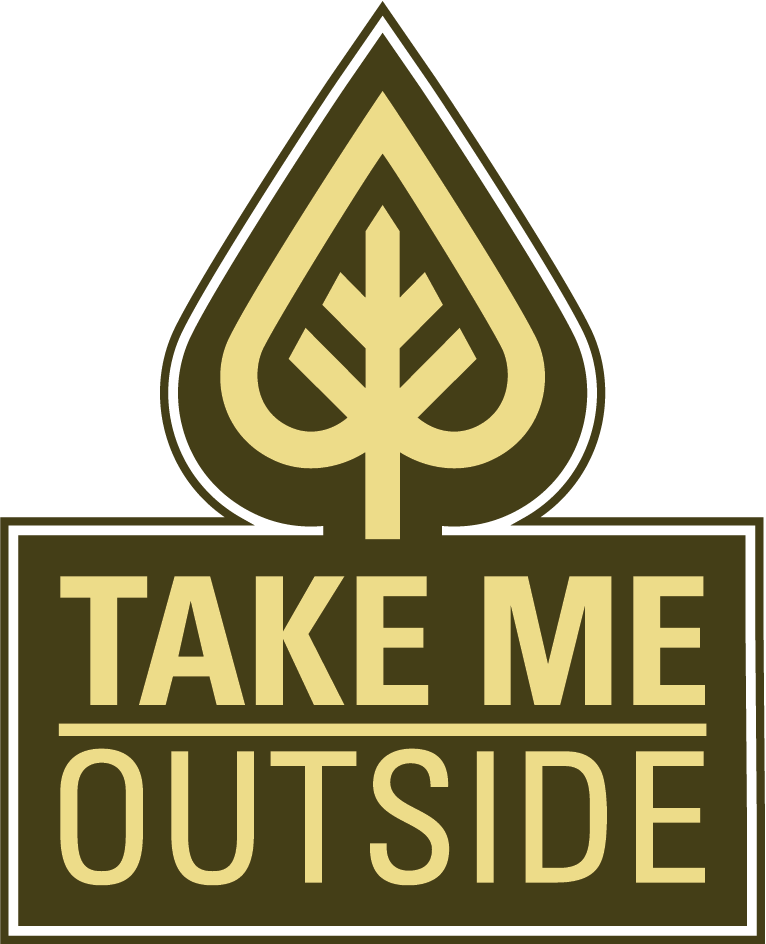Activity Ideas Inspired from Take Me Outside Day 2021
Take Me Outside Day 2021 was such a success, and we want to share some of the ideas that came out of that week, whether you were able to join us in October or not. Each day from Oct 18th – 22nd had a special theme, which is outlined below alongside the suggested activities.
Enjoy these for Take Me Outside Day and week, or any other day of the year!
Monday October 18th – Theme: Indigenous Knowledge
Below are some simple activities you can do with your students. For more resources on Indigenous knowledge, click here.
Grade: All Grades
Subjects: ANY
Teaching Strategies: Critical thinking, Place based learning, Collaborative learning
Choose an object to facilitate the listening circle, such as a small stone or a pine cone. The object is passed around from person to person, allowing only the person holding the object to speak. This enables all those present to be heard, especially those who may be shy. Sitting in silence for a few moments before the object is passed is also permitted. Consensus can focus on the object to move along, to assure that the “long winded” don’t dominate the discussion.
Please note: This activity is inspired by a “talking circle” which refers to a spiritual practice used in many Indigenous nations involving specific ceremonies, invitations to ancestors, and regional differences between nations. With the guidance of an elder or knowledge keeper, a talking stick circle could be used, in replacement of this less formal Listening Circle exercise.
Create a Land Acknowledgment
Grade: All Grades
Subjects: English/Language arts, Geography, Religion, Social Studies, History
Teaching Strategies: Place based learning, collaborative learning, critical thinking
This activity can be an individual task or a group/collaborative activity. Students can create their own land acknowledgment for their personal classroom. Encourage students to discuss and research Indigenous groups of Canada and their historical residences on this land. For elementary students, this may take the form of a poem or song. Give students time to reflect on their own personal relationship to the land.
For secondary students, consider asking questions like: What should a land acknowledgment say? Who should a land acknowledgment be for? What is the purpose of acknowledging the land?
Once students create their own land acknowledgment, allow them to write down pieces of their own onto a collaborative class document (on the chalkboard, chart paper, google docs, etc). Co-constructing a land acknowledgment can be a powerful tool in continuing to learn more about Indigenous groups and their importance to Canadian culture.
For more information, check out native-land.ca
Tuning into your Senses
Authored by Carolynne Crawley
Grades: All Grades
Subjects: Interdisciplinary
Teaching Strategy: Reflective Practice, Metacognition, Outdoor Learning
This activity should be guided while outdoors preferably in a garden, park, ravine, or any other
“green space.” It creates an opportunity for students to be in the present moment and tuned
into their surroundings through their senses. Invite students to get comfortable preferably
sitting. They may close their eyes if they feel comfortable to do so. Suggest they take a few
slow deep breaths. Then guide them slowly through each of their senses while giving them 30
seconds to notice what they are experiencing before moving onto the next sense. For example
asking the students “Bring your attention to your sense of smell. Perhaps take some long deep
breaths to notice any scents in the air.” “Notice the sounds surrounding you in this moment.
Notice the sounds closest to you and farthest from you” End the guided sensory experience
with their sense of sight by inviting them to open their eyes and notice their surrounding. Create an opportunity for sharing.
Notice Who is in Motion
Authored by Carolynne Crawley
Grades: All Grades
Subjects: Geography, Science, Health
Teaching Strategy: Outdoor Learning, Reflective Practices, Active learning
This activity should be guided while outdoors preferably in a garden, park, ravine, or any other
“green space.” Invite the students to move very slowly by setting the pace for them. Suggest
they move along a trail, walk way, or move around in the area and notice who is moving on the
land. Perhaps doing this in silence and another time not in silence while moving quickly. That
way students can learn that moving slowly in silence creates opportunity to notice more and
lessen the level of disturbance upon wildlife. Engage in this activity for five to twenty minutes.
Create an opportunity for students to share what they noticed as a group or in partners.
Memory a.k.a Kim’s Game
Authored by Carolynne Crawley
Grades: Grades K-6
Subjects: All Subjects
Teaching Strategy: Active learning, Reflective Learning
Find eight to twelve objects from nature such as feathers, leaves, stones, shells, seeds, etc.
Place them onto a table or floor with a cloth covering the objects. Invite the students to gather
around the table and remove the cloth to show them the items. The objects are to remain on
the table/floor. Give students up to 30 seconds to memorize the objects then cover them up.
Ask the students questions for memory recall such as How many objects are on the table?
Name the objects. Once a student names an object ask students specific questions to see if
they can recall any details about that object such as the shape, colour(s), and size. Once
students can no longer answer any of the questions about any of the objects remove the cloth
again for up to 15 seconds to create opportunity for students to retain more detailed information.
Once again ask students questions after covering up the objects. This can be adapted for any
subject. Instead of objects it could be words, numbers, or shapes that are used for memory
recall.
Tuesday October 19 – Theme: Health and Wellness
Below are some simple activities you can do with your students. For more resources on Health and Wellness, click here.
Silent Hiking
Grade: All Grades
Subjects: English/Language arts, Geography,Math, Phys Ed, Science
Teaching Strategies: Outdoor learning, Metacognition
This activity can take the form of 3 separate stages:
Pre Activity: Encourage students to reflect on spending time outdoors and getting active. What do students enjoy being outdoors? Discuss elements of physical and health literacy. Include a small physical warm up. This can include stretching, jogging on the spot. Students can measure their heart rate during the warm up and compare it with their results post hike.
During the Hike: Encourage students to be completely silent during the hike. Students should be aware of their senses. Ask students to listen, smell, touch, and see nature. Stop for a break if necessary.
Post Activity: Allow students to measure their heart rate, and compare results from the warm up. Use interdisciplinary teaching by asking them questions such as: What math equation gave them their heart rate measurement? What direction did we walk in? What animals did you notice? What were they doing? Ask students to jot down and reflect on their experience of the silent hike. They can also draw their experience, if preferred.
Pick It Up!
Subjects: Gym, Interdisciplinary
Teaching Strategies: Outdoor learning, Active learning, Reflective learning, Constructive learning
Help the environment while students practice their balance and coordination skills by picking up trash! This two- in -one activity encourages the development of fine motors skills and physical fitness for younger students. These skills transfer to sports and activities that involve dynamic balance and coordination.
Ensure that students pick up safe items by providing them with a graphic chart on what to pick up (i.e wrappers, water bottles).
This activity can be paired with a post discussion or personal reflection on recycling and caring for the environment, as it relates to relevant curricula.
For other variations on this activity, visit activeforlife.com
Grades: All Grades
Subjects: Gym
Teaching Strategies: Active learning, Outdoor learning
Feel like warming up before our Virtual Yoga session led by Satya Studios? Continue your yoga skills with this activity! “Balance Poses’ is a great starter activity to develop balance and coordination skills, and can be used for a variety of skilled yogis! Just add more moves to challenge advanced learners, or focus on developing ambidexterity.
For more ideas to learn and play in the great outdoors, visit activeforlife.com
Get Your Ears On!
Subjects: Interdisciplinary
Teaching Strategies: Communicative Practice, Reflective Learning, Metacognition
Can you [ear] me? This activity focuses on mental health awareness, specifically eco-anxiety. By encouraging students to discuss their feelings on the future of our environment, the hope is eliminate feelings of anxiety.
Have fun with this activity by encouraging students to wear animal ears when they feel a need to talk or discuss concepts that make them worries or anxious.
Students can make the ears of any animal of their choosing! Find the animal ear template, here.
For more resources on eco-anxiety and other activities focused on the environment check out The Earths Rangers Podcast for elementary students!
For secondary students, check out Earth Ranger’s Podcast “The Big Melt” !
Wednesday October 20 – Theme: Take Me Outside Day!
Below are some simple activities you can do with your students. For more resources on Outdoor Learning, click here.
Nature Walk
Grades: All Grades
Subjects: Interdisciplinary
Teaching Strategies: Collaborative learning, Group work, Critical thinking, interdisciplinary learning.
This activity is (literally) a walk in the park! Students will love to explore on their own terms and teachers can support their exploring with the following curricula links and pedagogical practices. Make this an interdisciplinary activity by splitting students up into groups by subject. Each subject group will be tasked with connecting their subject in nature during the walk. When students return to class, pass chart paper around to make it a collaborative post-walk activity. Encourage students to bring back pieces of expired nature (such as a leaf, stick, etc.) to add to their chart paper.
Challenge secondary students by asking them to use critical thinking strategies by making a mind map of the nature walk with connections to each relevant interdisciplinary subject.
Growing Flowers
Subject: Gym, interdisciplinary
Teaching Strategies: Active Learning, Reflective learning, Outdoor learning,
Have students be physically active and spend time outdoors with this activity! Students can mimic the sway of flowers in the wind and other ‘plant’ actions. This can be an introductory activity to science or geography.
For more ideas to learn and play in the great outdoors, visit activeforlife.com
Thursday October 21 – Theme: Environmental & Climate Change Education
Below are some simple activities you can do with your students. For more resources on Environmental and Climate Change Education, click here.
Grade: 7-12
Subjects: Science and Geography
Teaching Strategies: Active learning, Reflective Learning
Ask the participants to stand in a circle. Give the end of the string to the participant that answers the first question: Where does all the energy in the world come from? Whoever answers “the sun“, gets the ball of wool, holds onto it and hands the ball to the person that answers the question.
What makes all its food from the light of the sun? Whoever answers plants,(or any specific plant) gets the ball of wool. What eats flowers, grass etc? When someone mentions an animal, then you hand them a piece of wool – essentially linking them to each other. Try and take answers from people on either ends to get the wool overlapping and create a good web effect. Then ask what eats the animal mentioned and continue on asking questions to create a description of a working
ecosystem – Now you have an ecology web! Next use a realistic example to illustrate the knock on impacts of removing one part of the ecosystem. For example, a school group came to this field for a visit and picked all the wild flowers. Anyone who is a flower must sit on the ground and bring their string with them. Anyone who feels a pull on this string
must also sit down because that means this is the food they eat so they will not survive. Eventually everyone should be sitting on the ground.
Processing questions:
• How can humans negatively affect the ecosystem?
• Are there things we can change today to minimize our impact?
• Is there anything happening locally that is impacting the ecosystem?
Tips:
• Hand out cards with animals and plants already printed.
• Get the group to think of things happening locally that impact the ecosystem.
For more resources concerning environmental education, visit leavenotracecanada.ca
Grade: 4-8
Subjects: Science and Geography
Teaching Strategies: Active learning, Reflective Learning
Lay seven cards on the ground in front of the group with a different principle on each. Start reading out statements. Find the 7 principles here.
Have the groups guess the correct principle by moving to and standing beside the principle they feel the statement relates most closely to. Continue until you feel the group have a greater under-standing and awareness of the Leave No Trace principles.
Processing Questions
• Was it always clear which principle the statements related to?
• Did certain statements apply to a number of principles?
• Can participants think of their own statements that could apply to Leave no Trace?
• Are any of the principles more relevant to this group and locality?
• Were the group surprised by any of the statements?
For more resources concerning environmental education, visit leavenotracecanada.ca
Citizen Science and Photography
Grade: 7-12
Subjects: English/Language arts, Geography, Phys. Ed, Science
Teaching Strategies: Constructive Learning, Outdoor Learning, 21st Century Learning
Have students bring their personal devices such as a cell phone with them on a walk around school grounds or the community. Instruct students to take pictures of anything that strikes them in a positive or negative way, through the lens of our relationship with nature.
If bringing student devices is not possible, bring your own device and ask students to tell you what to take pictures of.
Coming back to class, deconstruct these photos. Allow students to reflect on why this photo struck them, and how it connects to our relationship with nature.
Encourage students to study the science behind the photo (ex. If a photo of litter was taken, students may want to research how pollution effects the environment, the rates of different kinds of pollution, etc)
Have students post their photo on a collective platform, such as Google Jam-board. Begin a discussion looking at all the photos that the students had taken on their walk, and reflect on our relationship with nature (both positive and negative reflections).
Alternatively, you can print out each photo and set up different stations around the class and construct an “art show” view of each photo, were students visit each station and discuss the photo with the photographer.
Grades: ANY
Subjects: Interdisciplinary
Teaching Strategies: Outdoor Learning
Take your students outside. Bring writing materials like a piece of paper or journal and a pencil. Have students first LOOK around them and record what they see on their piece of paper. This could be done through a lens of any subject (i.e. what type of biodiversity do you see? What type of physical landscape do you see?). Visit this place frequently (over the course of a week or longer) so students can keep track of their recordings and measure any differences of that outdoor space. At the end of the week, have students compare their findings and asked what they recorded. Begin a class discussion with their findings. to see this activity in more detail!
Friday October 22 – Theme: Day of Reflection
Below are some simple activities you can do with your students. For more resources on Reflective Practices, click here.
Sit Spot
Grade: All Grades
Subjects: English/Language arts, Geography, Phys. Ed, Science
Teaching Strategies: Reflective Learning, Outdoor Learning
Take your students outside, and encourage them to sit in a spot that appeals to them. The idea of this activity is to revisit the same spot, and observe any changes to the area. Have students reflect on Take Me Outside week and everything that transpired! To enhance this activity, try journaling in the sit spot! See below for more details.
Reflective Journal
Grade: 4-12
Subjects: English/Language arts, Geography, Phys. Ed, Science
Teaching Strategies: Reflective Learning, Outdoor Learning
Encourage students to journal and jot down their experiences in nature, in the form of past, present, and what they hope their experiences will be like in the future. Have students bring out a notebook, piece of paper, or allow them to take notes on their cell phones for older grades.
Students can also reflect on the events that transpired for Take Me Outside week! Another idea is to encourage students to jot down their observations in nature using the 4 senses: sight, touch, smell, and hear.
Indigenous Resources from Natural Curiosity
Educators
Engage in reflective thinking practices as an educator!
Click here to learn how to incorporate the 4 branches of environmental education through an Indigenous lens.
Listen, Read, Think
Educators
Engage in reflective thinking practices as an educator! Tune into Green Teacher podcasts for some practice in critical thinking and reflection on a wide range of topics concerning the environment and outdoor learning. Fun fact: Our Executive Director Colin Harris is a featured guest! Click here
Expand your reflections and new knowledge through reading articles by Green Teacher! For access to a FREE 6 pack article during Take Me Outside week, Click here!









